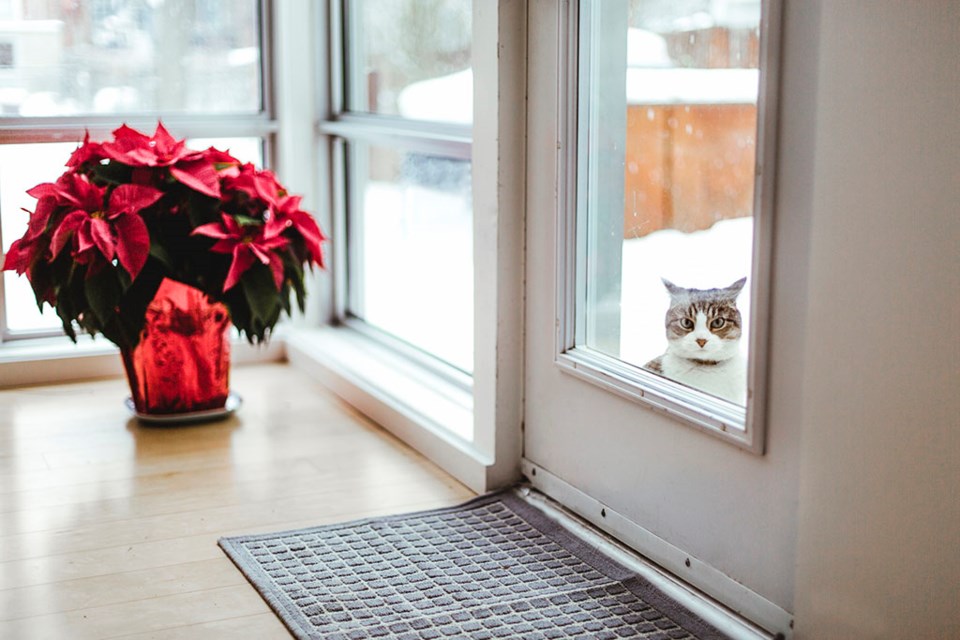Poinsettias are synonymous with the holiday season. These colorful plants brighten up homes with their vibrant hues in variations of red, white and pink, making them a holiday decoration many people cannot live without.
While they’re most visible during the often chilly holiday season, poinsettias prefer warm weather. Poinsettias are native to Central America and originally flourished in an area of southern Mexico. The Aztecs used the plant for decorative and medicinal purposes.
The poinsettia may have remained a regional plant if not for the efforts of Joel Roberts Poinsett, who was the first United States Ambassador to Mexico under President James Madison. Poinsett, who would later found the Smithsonian Institution, had a love of botany and became enamored with the brilliant red plants he saw in Mexico. Eventually, Poinsett began growing the plants at home in 小蓝视频 Carolina, and friends and others soon coveted them.
Poinsettias are beautiful and the bracts (modified leaves) can be vibrantly colored. That signature vibrancy is why many people would like to preserve their poinsettias to last beyond the New Year, which is possible with the right care. The following are some tips, courtesy of Mother Nature’s Network, Habersham Gardens, Oregon Live, and Phoenix Flower Shops, to keep poinsettias thriving past the holiday season.
• Start with healthy plants that have full leaves, bracts and deep colors.
• Poinsettias do best when the temperature is between 65 and 75 F. Temperatures below that or drafts from cold windows can cause leaves to drop.
• Position the plant in a room that gets indirect sunlight for at least six hours per day. If direct sunlight can’t be avoided, diffuse the light with a sheer curtain.
• Poinsettias need well-drained soil. Overwatering or allowing roots to sit in wet soil can cause the leaves to fall off prematurely. Water thoroughly only when the pot looks dry. In households with temperatures around 70 F, the plant should be watered about once a week.
• Fertilize the plant after the blooming season with a balanced, all-purpose fertilizer.
• Try placing poinsettias in or near a bathroom, as they prefer high humidity.
It may be possible to get poinsettias to rebloom next season. Allow the poinsettias to dry out a little more in the spring. In May, cut about four inches from each stem to produce a lush, full plant during the winter. The plants can be moved outside in June and during the summer, but keep them away from direct sunlight. Return the poinsettias indoors beginning around October. Make sure the plants get at least 12 hours of darkness per day for around eight weeks in October and November. This will help them develop a deep hue and bloom on time for Christmas. While they’re most visible during the often chilly holiday season, poinsettias prefer warm weather. Poinsettias are native to Central America and originally flourished in an area of southern Mexico. The Aztecs used the plant for decorative and medicinal purposes.
The poinsettia may have remained a regional plant if not for the efforts of Joel Roberts Poinsett, who was the first United States Ambassador to Mexico under President James Madison. Poinsett, who would later found the Smithsonian Institution, had a love of botany and became enamored with the brilliant red plants he saw in Mexico. Eventually, Poinsett began growing the plants at home in 小蓝视频 Carolina, and friends and others soon coveted them.
Poinsettias are beautiful and the bracts (modified leaves) can be vibrantly colored. That signature vibrancy is why many people would like to preserve their poinsettias to last beyond the New Year, which is possible with the right care.
The following are some tips, courtesy of Mother Nature’s Network, Habersham Gardens, Oregon Live, and Phoenix Flower Shops, to keep poinsettias thriving past the holiday season.
• Start with healthy plants that have full leaves, bracts and deep colors.
• Poinsettias do best when the temperature is between 65 and 75 F. Temperatures below that or drafts from cold windows can cause leaves to drop.
• Position the plant in a room that gets indirect sunlight for at least six hours per day. If direct sunlight can’t be avoided, diffuse the light with a sheer curtain.
• Poinsettias need well-drained soil. Overwatering or allowing roots to sit in wet soil can cause the leaves to fall off prematurely. Water thoroughly only when the pot looks dry. In households with temperatures around 70 F, the plant should be watered about once a week.
• Fertilize the plant after the blooming season with a balanced, all-purpose fertilizer.
• Try placing poinsettias in or near a bathroom, as they prefer high humidity.
It may be possible to get poinsettias to rebloom next season. Allow the poinsettias to dry out a little more in the spring. In May, cut about four inches from each stem to produce a lush, full plant during the winter. The plants can be moved outside in June and during the summer, but keep them away from direct sunlight. Return the poinsettias indoors beginning around October. Make sure the plants get at least 12 hours of darkness per day for around eight weeks in October and November. This will help them develop a deep hue and bloom on time for Christmas.




